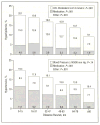Relationship of distance run per week to coronary heart disease risk factors in 8283 male runners. The National Runners' Health Study
- PMID: 9009976
- PMCID: PMC3756592
Relationship of distance run per week to coronary heart disease risk factors in 8283 male runners. The National Runners' Health Study
Abstract
Background: Official guidelines from the Centers for Disease Control and Prevention and the American College of Sports Medicine state that every adult should accumulate 30 minutes or more of moderate-intensity physical activity on most, preferably all, days of the week.
Objective: To examine the dose-response relationship between coronary heart disease (CHD) risk factors and vigorous exercise above the recommended minimum levels to assess whether further benefits accrue.
Methods: Physician-supplied medical data were compared with reported distance run in a national cross-sectional survey of 8283 male recreational runners.
Results: Compared with runners who ran less than 16 km (10 miles) per week, long-distance runners (> or = 80 km/wk) showed an 85% reduced prevalence of high-density lipoprotein cholesterol levels that were clinically low (< 0.9 mmol/L [< 35 mg/dL]), a 2.5-fold increased prevalence of clinically defined high levels of high-density lipoprotein cholesterol (ie, > or = 1.55 mmol/L [> or = 60 mg/dL], the level thought to be protective against CHD), a nearly 50% reduction in hypertension, and more than a 50% reduction in the use of medications to lower blood pressure and plasma cholesterol levels. Estimated age-adjusted 10-year CHD risk was 30% lower in runners who averaged more than 64 km/wk than in those who averaged less than 16 km/wk (42 vs 61 events per 1000 men). Each 16-km incremental increase in weekly distance run up to 64 to 79 km/wk was associated with significant increases in high-density lipoprotein cholesterol levels and significant decreases in adiposity, triglyceride levels, the ratio of total cholesterol to high-density lipoprotein cholesterol level, and estimated CHD risk.
Conclusions: Our data (1) suggest that substantial health benefits occur at exercise levels that exceed current minimum guidelines and (2) do not exhibit a point of diminishing return to the health benefits of running at any distance less than 80 km/wk.
Figures



Comment in
-
Dose of exercise and health benefits.Arch Intern Med. 1997 Jan 27;157(2):153-4. Arch Intern Med. 1997. PMID: 9009971 No abstract available.
References
-
- Centers for Disease Control and Prevention and American College of Sports Medicine. cooperation with the President’s Council on Physical Fitness and Sports. Summary Statement: Workshop on Physical Activity and Public Health; July 29, 1993.Indianapolis, Ind: American College of Sports Medicine;
-
- Hahn RA, Teutsch SM, Rothenberg RB, Marks JS. Excess deaths from nine chronic diseases in the United States, 1986. JAMA. 1990;264:2654–2659. - PubMed
-
- McGinnis JM, Foego WLL. Actual causes of death in the United States. JAMA. 1993;270:2207–2212. - PubMed
-
- Fletcher GF, Froelicher VF, Hartley H, Haskell WL, Pollock ML. Exercise standards: a statement for health professionals from the American Heart Association. Circulation. 1990;82:2286–2322. - PubMed
-
- Blair SN, Kohl HW, Gordon NF, Paffenbarger RS. How much physical activity is good for health? Ann Rev Public Health. 1992;13:99–126. - PubMed

